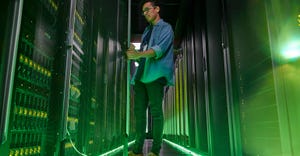7 Open Source Tools to Consider for Your Data Center
These seven open source tools can help optimize data center efficiency and agility while reducing costs.

If you want to reduce data center operating costs while also maximizing agility, open source software tools may be up your alley. Although open source tools certainly don't guarantee a lower overall cost, the fact that they don't come with licensing fees makes them attractive compared with most commercial software that you'd use to help manage a data center or workloads inside it. Plus, open source tools pose a lower risk of locking you into a particular vendor's platform or ecosystem.
So, let's take a look at some of the most popular open source tools for data centers. Some are designed for needs specific to data centers, while others are open source solutions that support a variety of use cases, including but not limited to data centers.
1. OpenDCIM
Data center infrastructure management, or DCIM, is the complex process of tracking and managing all of the components that exist inside a data center — including not just IT equipment but also cooling systems, power systems, and other operational infrastructure.
OpenDCIM is a free and open source tool designed to simplify DCIM. It offers a web-based interface for mapping data center components and tracking their status. It also provides some basic request management features, and it comes with a privileged access management framework so that you can configure multiple users with different permission levels — which is useful if some team members need to perform different types of tasks than others, and you don't want them to share the same permissions within your DCIM software.
2. NetBox
NetBox is another open source tool designed to help address DCIM needs, although it focuses especially on the management of network architectures and resources.
NetBox stands out from most other open source data center tools through its heavy investment in automation solutions. It provides APIs that help with the automation of complex workflows, making NetBox a great open source tool for your data center if you need to manage infrastructure at large scale.
3. RackTables
Alongside OpenDCIM and NetBox, RackTables rounds out the world of popular open source DCIM tools. RackTables is by many measures the simplest and least sophisticated solution in this category, and you may even feel a bit like you're still in the 2000s when you use it. But it's a user-friendly tool that allows you to track data center assets effectively, and it's free and open source, so you can't really complain.
4. Nmap
Sometimes, you just want to figure out which resources are running on the network inside your data center. You don't need a complicated DCIM tool to do that. You can use Nmap, an open source tool that scans networks and provides detailed information about hosts operating on them — including hosts you might not have known existed on your network.
5. Tinkerbell
You could go and set up every server in your data center by hand. But that would take a very long time. An alternative option is to use Tinkerbell, an open source data center tool designed to automate the provisioning of bare-metal infrastructure. Using declarative configurations, you can set up servers automatically and at scale, even if the servers don't already have an operating system installed on them.
6. Prometheus
For monitoring workloads deployed in your data center, arguably the very best solution that the open source world has to offer is Prometheus. (You could argue that Zabbix, another open source monitoring solution, is better, but I'll save that debate for a different day.)
7. Grafana
You can't really mention Prometheus without mentioning Grafana, an open source tool that is often used alongside Prometheus. Grafana provides data visualization features to help teams interpret monitoring data. In most setups, you'd use a tool like Prometheus to collect the monitoring data, then send it to Grafana to help your team visualize and interpret it.
Conclusion
From DCIM, to network mapping, to bare-metal provisioning and beyond, the open source community offers a number of tools to help manage data centers and the infrastructure and workloads running in them. We're not saying open source solutions are always the best for meeting your data center needs, but they may well be, and they're certainly worth considering alongside commercial solutions.
About the Author
You May Also Like









